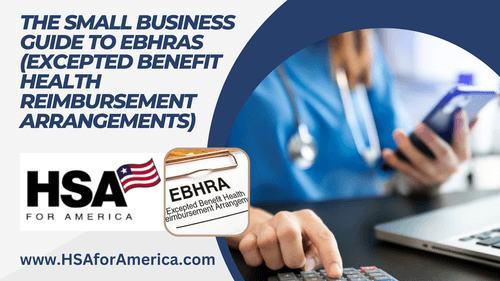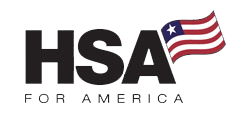
While Excepted Benefit Health Reimbursement Arrangements aren’t for every business, they can be a great way to help make a broader range of health benefits more affordable for employees – while saving taxes at the same time.
This guide will show how offering an EBHRA can help your business save money, while still offering a powerful health benefit that helps you attract and retain quality talent. So you can stay competitive with larger companies.
EBHRAs are a way for employers to help with health costs tax-free. They let employees use money on dental and vision care. This gives workers a say in how they use their health funds. It also helps cover costs not always paid by standard health plans.
With an EBHRA, you can offer a better set of health benefits to your team for a more affordable cost. It would be great if your employees had health insurance from elsewhere. Or if they like keeping their own plans. It opens up more choices for everyone.
Key Takeaways
- EBHRAs are tax-advantaged health reimbursement arrangements covering excepted dental and vision care benefits.
- Employers can contribute up to $1,950 per year (as of 2023) to an EBHRA, with contributions being tax-free for employees.
- EBHRAs offer flexibility for employees in managing their healthcare expenses, even if they don’t participate in the company’s group health plan.
- These arrangements can help small businesses attract and retain top talent by providing comprehensive health benefits.
For free help designing and implementing your EBHRA or any other health plan for your small business, make an appointment with a Personal Benefits Manager.
Introduction to EBHRAs
The acronym EBHRA stands for Excepted Benefit Health Reimbursement Arrangement.
It’s a special health plan that helps employees pay certain medical costs not included in their group health insurance policy with tax-free dollars. These include deductibles, copays, and supplemental coverages such as dental and vision care.
To understand how they work, you must understand what an excepted benefit is.
In summary, an excepted benefit is a benefit that is exempt from the generally applicable health insurance benefits under the HSA, such as dental, vision, or accident insurance.
An EBHRA allows employers a way to reimburse workers with tax-free dollars to help them afford a wider array of benefits than they could afford on their own.
Importance of EBHRAs in Modern Benefits Packages
EBHRAs help employees fill in gaps where their traditional group health insurance policies fall short. They help pay for things like copays and deductibles. This means less pressure on employees and their families to pay these costs.
| Benefit | Description |
|---|---|
| Additional Health Benefits | EBHRAs supplement traditional group health plans, providing additional coverage for expenses not fully covered by primary insurance. |
| Financial Security | By reducing out-of-pocket costs, EBHRAs help alleviate the financial burden on employees and their families. |
| Flexibility | Employees have greater flexibility in utilizing their healthcare dollars, allowing them to prioritize their specific health needs. |
| Employee Well-being | EBHRAs demonstrate an employer's commitment to their employees' health and well-being, fostering a positive work environment. |
How do EBHRAs Work?
EBHRAs are tax-advantaged, employer-funded vehicles that employers may offer alongside your group health insurance plan.
This is an important difference compared to Qualified Small Employer Health Reimbursement Arrangements (QSEHRAs), which can only be offered by small businesses with fewer than 50 full-time equivalents (FTEs) who don’t offer group health insurance at all. EBHRAs must be accompanied by a group health plan.
However, employees don’t need to join your group health plan to benefit from your EBHRA. Your EBHRA can help them buy additional supplemental benefits even if they have insurance from a different source, such as a spouse’s employment plan or the VA.
With EBHRAs, you decide how much you will contribute and what specific types of expenses you want your plan to reimburse.
By offering an EBHRA alongside your group health insurance plan, you help workers pay for a broader and more complete set of health-related benefits.
Eligible Expenses under EBHRAs
Out-of-Pocket Medical Expenses
EBHRAs also help with various medical costs. They can pay for copays, prescription drugs, and more. This includes mental health and substance abuse treatment.
Employers decide what medical expenses EBHRAs can cover. They do this to match the plan with what their employees need.
Here are the most important benefits workers can use EBHRA funds for:
EBHRA-Eligible Expenses
1. Dental Coverage:
- Dental insurance premiums
- Out-of-pocket dental expenses
2. Vision Coverage:
- Vision insurance premiums
- Out-of-pocket vision care expenses
3. COBRA continuation coverage premiums:
- Premiums for COBRA continuation coverage
4. Short-term Limited Duration Insurance (STLDI):
- Premiums for short-term health insurance plans
5. Long-term Care expenses, including:
- Long-term care insurance premiums
- Nursing home care
- Home healthcare
- Community-based care
6. Cost Sharing:
- Copays
- Deductibles
- Co-insurance
7. Accident Insurance:
- Premiums for accident insurance policies
8. Disability Insurance premiums
9. Cancer insurance premiums
10. Critical Illness Insurance
11. Other Medical Expenses:
- Out-of-pocket medical expenses that qualify under IRS Code § 213(d)
These benefits are designed to supplement traditional group health plans and help employees manage additional healthcare costs.
What’s Not Eligible for an EBHRA?
EBHRAs aren’t designed to cover everything. While EBHRAs cover a wide range of expenses, there are certain items that are not eligible for reimbursement:
- Medicare premiums
- Individual health insurance premiums
- Group health premiums (other than COBRA continuation coverage)
- Any premiums or expenses that do not fall under the category of excepted benefits
Employer Contributions and Tax Advantages
As of 2024, employers contribute up to $2,100 in pre-tax dollars to an EBHRA per worker. These contributions are all deductible to employers as a contribution expense.
Meanwhile, EBHRA contributions are not taxable to the employee.
Moreover, EBHRA contributions are exempt from payroll taxes and state and federal income taxes, which saves money for employers and workers.
Because EBHRA contributions aren’t subject to income tax or payroll taxes, they are a much more tax-efficient way to provide benefits compared to simply giving employees cash to buy these benefits on their own.
Various HRA Contribution Limits 2024-2025
Here’s a look at how EBHRA contribution limits can stack up against other health benefit choices:
| HRA Type | 2024 Contribution Limit | 2025 Contribution Limit |
|---|---|---|
| EBHRA | $2,100 | $2,150 |
| QSEHRA (self-only) | $6,150 | TBA |
| QSEHRA (family) | $12,450 | TBA |
| ICHRA | No limit | No limit |
| GCHRA | No limit | No limit |
Enhancing Employee Wellness and Satisfaction
An EBHRA investment boosts employee health and happiness.
This creates a workplace where people feel cared for and valued. They tend to be more productive, loyal, and enjoy working for you.
As of 2024, employees can get up to $2,100 a year. Unlike Flexible Spending Arrangements (FSAs), there are no “use-it-or-lose-it” rules. If a worker doesn’t use up all his or her EBHRA funds, that money can carry over to the next year. This way, you provide strong support for their health costs every year.
Including an EBHRA in your benefits shows that your top priority is your team’s health. It helps to be a top choice for job seekers in today’s tough job market.
EBHRA Regulations and Guidelines
Nondiscrimination Rules and ERISA Requirements
EBHRAs have to treat all staff the same, according to U.S.C §105(h).
This includes everyone, from the highest earners to the lower paid. The idea is to ensure fairness for all.
Also, EBHRAs have to meet certain ERISA laws, unless they’re exempt. This includes telling workers about the plan and its perks. Employers need to give out a clear summary of the EBHRA.
HIPAA Compliance and Exceptions
HIPAA has its own set of rules for EBHRAs.
EBHRAs have to meet these rules, unless they fall under some exceptions. But, they don’t have to follow all the rules that HRAs usually do.
To stay right with EBHRA rules, employers need to keep up with paperwork and reporting. This can include filing Form 5500, if it’s needed.
By knowing and following these EBHRA rules, your business’s benefits stay fair and valuable. Plus, you get to enjoy some tax benefits and flexibilities with EBHRAs.
HRA Plans at a Glance
| HRA Type | Eligibility | Contribution Limits | Reimbursable Expenses |
|---|---|---|---|
| EBHRA | Organizations of any size that offer a group health plan | Up to $2,100 in 2024 | Excepted benefits only (e.g., dental, vision, COBRA, long-term care, disability insurance, critical illness insurance. But not Medicare premiums or individual health insurance premiums. |
| ICHRA | Employers of any size | No caps on contribution limits | Individual health insurance policies and out-of-pocket medical expenses |
| QSEHRA | Small businesses with fewer than 50 full-time employees. Only available to employers that do not sponsor a group health plan. | Up to $5,850 for single employees and $11,800 for families in 2023 | Individual health insurance policies and out-of-pocket medical expenses |
EBHRA Non-Discrimination Rules
If you offer an EBHRA, you must ensure that all eligible employees receive these benefits fairly and uniformly.
That means you can’t pick and choose favored employees, but you must offer the same benefits to all employees within a given class. Here are the key points regarding the non-discrimination rules for EBHRAs:
Uniform Availability
You must offer access to EBHRAs under the same terms and conditions to all similarly situated individuals.
Benefits, contribution amounts, and eligibility criteria must be consistent across all workers and employees who are in the same class and category within your company.
Classification of Employees
You must classify employees based on bona fide employment-based classifications as defined by HIPAA nondiscrimination rules. These classifications can include:
- Full-time vs. part-time status
- Occupation
- Geographic location
- Length of service/seniority
- Date of hire/seniority
- Collectively bargained employees
Prohibited Discrimination Criteria
EBHRAs cannot discriminate based on health factors.
This means that eligibility and benefits cannot be determined based on an employee’s health status, medical condition, claims experience, receipt of healthcare, medical history, genetic information, evidence of insurability, or disability.
Highly-Compensated Employees
EBHRA rules generally prohibit discrimination in favor of highly compensated individuals.
This ensures that the benefits are not disproportionately offered to higher-paid employees. You must offer the benefit to rank and file employees as well as your senior management, or your senior managers will not get the tax break.
ERISA and HIPAA Requirements
EBHRAs are subject to the Employee Retirement Income Security Act (ERISA) unless an exception applies.
This includes requirements for claims and appeal procedures, summary plan descriptions, and other ERISA mandates.
EBHRAs must also comply with HIPAA’s administrative simplification requirements, including privacy and security rules, unless an exception applies.
Employee Onboarding and Education
Employee education and ongoing plan communication is important.
Employees can’t place value on a benefit they don’t know about or don’t know how to use. Make sure your team knows how the EBHRA works, what bills it covers and doesn’t cover, and how to request reimbursement.
At a minimum, implement these employee communication measures:
- Issue your summary plan description (SPD) outlining the EBHRA’s terms and conditions
- Distribute educational materials, such as brochures or videos, explaining the benefits of the EBHRA
- Conduct training sessions and/or webinars to guide employees through the claims submission process
- Open and maintain dedicated support channels for employee questions and concerns
Hire an HRA Administrator
Most small businesses that don’t have a dedicated HR office don’t try to administer EBHRAs in house.
Consider hiring a skilled HRA administrator to work alongside your HSA For America Personal Benefits Manager.
HRA Administrators take the compliance workload and stress off of small businesses that offer HRAs, such as the EBHRA.
Here’s what your HRA Administrator can help with:
| Compliance Management | Reporting and Documentation | Employee Support |
|---|---|---|
| Tax reporting | Claims processing and reimbursement | Digital platform for claim submission |
| Drafting key plan documents, such as your summary plan description | Record keeping and data storage | Dedicated customer support |
| ERISA compliance, such as Form 5500 filing | Summary plan descriptions (SPDs) | Educational resources and guides |
| HIPAA compliance | Nondiscrimination testing under IRC Section 105(h) | Onboarding assistance |
You can focus on your business by outsourcing HRA administration to professionals with HRAs as their core competency.
In short, an HRA administrator makes handling an EBHRA easier. They use their know-how and tools to help you follow the law. This way, you make the most for your employees and build a workplace that boosts their health and happiness.
Combining EBHRAs With Other Health Benefits and Plans
Smart companies routinely combine EBHRAs with other health benefits.
For example, you can offer an EBHRA and also contribute to health savings accounts for employees that are also enrolled in a qualified high deductible health plan, or HDHP.
However, you can’t offer both an Individual Coverage HRA (ICHRA) and an EBHRA to the same class of employees. This ensures that the benefits are structured in a way that maintains HSA eligibility for those who are enrolled in an HDHP, and they won’t be accidentally disqualified.
Learn More: The Most Effective Health Benefit Strategies For Employers With Fewer Than 50 Employees
Compare Pricing on the Best HealthShare Plans Available
Conclusion
By offering an EBHRA along with a quality group health insurance plan, you can help your employees afford a wider range of important health benefits than they could on their own.
EBHRAs allow your businesses to reimburse both health costs and out-of-pocket expenses tax-free.
Your HSA for America Personal Benefits Manager can help you design your health benefits package, including finding the most cost-effective health plans available and deciding which HRAs, including the EBHRA, may make the most sense for your organization.
We can also provide your employees with enrollment assistance. We make it easy for you to offer a great set of health benefits to help your employees access the great healthcare they deserve.
What to do Now
If you’re a small business owner or senior manager responsible for your company’s health benefits, or you’re looking for an affordable health plan for yourself and your family, make an appointment with one of our expert Personal Benefits Managers.
We’ll ask you a few questions and help you analyze your needs and budget, and work with you to design the most cost-effective plan for you.
It’s easy, and stress-free, and there’s never a charge for our services. Meanwhile, by leveraging the experience and expertise of an HSA for America Benefits Manager, you can potentially save a great deal of money for your business and employees in plan costs and taxes.
Must Reads: The Small Business Owner’s Guide to Starting a Section 125 Cafeteria Plan | Best Practices for Communicating Employee Benefits | How To Design an Effective Employee Benefits Program
Read More About Group Health Insurance Options in Your State

Hi! I’m Misty Berryman, and I’m one of your Personal Benefits Managers. I like working with HSA for America because we’re creating solutions to healthcare problems. Our focus on money-saving alternatives like HSA plans and health sharing programs, and the variety of health share programs we offer, are what set us apart. Read more about me on my Bio page.


